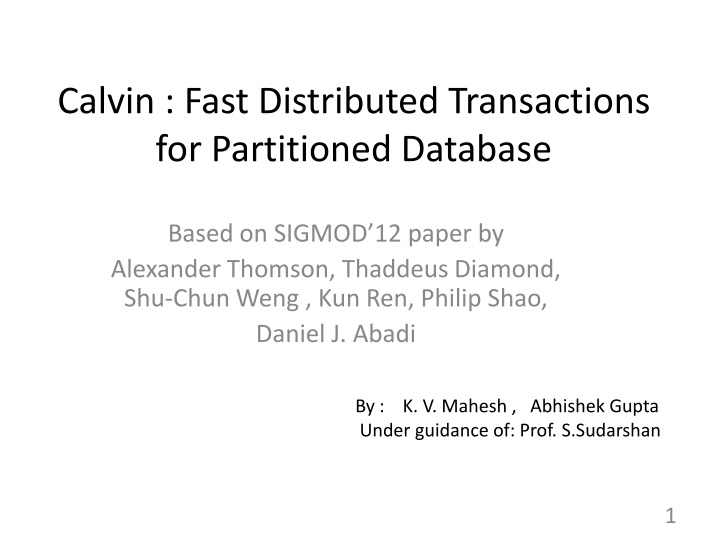
Distributed Transactions in Partitioned Databases: Calvin System Overview
Explore the Calvin system's fast distributed transaction approach for partitioned databases, addressing scalability and consistency tradeoffs while avoiding traditional agreement protocols. Learn about deterministic databases and their impact on transaction scheduling and execution order.
Download Presentation

Please find below an Image/Link to download the presentation.
The content on the website is provided AS IS for your information and personal use only. It may not be sold, licensed, or shared on other websites without obtaining consent from the author. If you encounter any issues during the download, it is possible that the publisher has removed the file from their server.
You are allowed to download the files provided on this website for personal or commercial use, subject to the condition that they are used lawfully. All files are the property of their respective owners.
The content on the website is provided AS IS for your information and personal use only. It may not be sold, licensed, or shared on other websites without obtaining consent from the author.
E N D
Presentation Transcript
Calvin : Fast Distributed Transactions for Partitioned Database Based on SIGMOD 12 paper by Alexander Thomson, Thaddeus Diamond, Shu-Chun Weng , Kun Ren, Philip Shao, Daniel J. Abadi By : K. V. Mahesh , Abhishek Gupta Under guidance of: Prof. S.Sudarshan 1
Outline Motivation Deterministic Database Systems Calvin : System Architecture Sequencer Scheduler Calvin with Disk based storage Checkpointing Performance Evaluation Conclusion 2
Motivation Distributed storage systems to achieve high data access throughput Partitioning and Replication Examples BigTable, PNUTS, Dynamo, MongoDB, Megastore What about Consistency ? What about scalability ? It does not come for free. Some thing has to be sacrificed Major three types of tradeoffs 3
Tradeoffs for scalability 1. Sacrifice ACID for scalability Drops ACID guarantees Avoids impediments like two phase commit,2PL Examples: BigTable, PNUTS Reduce transaction flexibility for scalability Transactions are completely isolated to a single partition Transactions spanning multiple partitions are not supported or uses agreement protocols Examples: VoltDB Trade cost for scalability Using high end hardware Achieves high throughput using old techniques but don t have shared- nothing horizontally scalability Example: Oracle tops TPC-C 2. 3. 4
Distributed Transactions in Traditional Distributed Database Agreement Protocol Ensures atomicity and durability Example : Two Phase commit Hold Locks till the end of agreement protocol Ensure Isolation Problems : Long transaction duration Multiple Round trip message Agreement Protocol overhead can be more than actual transaction time Distributed Deadlock T1 5
In nutshell distributed transactions are costly because of Agreement protocol Can we avoid this agreement protocol?? Answer: Yes Deterministic Databases 6
Deterministic Database Approach Provides transaction scheduling layer Sequencer decides the global execution order of transactions before their actual execution All replicas follow same order to execute the transactions Do all "hard" work before acquiring locks and beginning of transaction execution 7
Deterministic Database System Alexander thomson et al.,2010 What are the events that may cause a distributed transaction failure ? Nondeterministic - node failure , rollback due to deadlock Deterministic - logical errors 8
Deterministic Database System(2) If a non-deterministic failure occur A node is crashed , in one replica Other replica executing same transaction in parallel Run transaction using live replica Commit transaction Failed node would be recovered later Node crashed T1 T1 A A B B C C D D Replica 1 Replica 2 9
Deterministic Database System(3) But need to ensure Every replica need to be going through same sequence of database states To ensure same sequence of states across all replicas Use synchronous replication of transaction inputs across replicas Change concurrency scheme to ensure execution of transaction in exactly same order on all replica Notice this method will not work in traditional database. 10
Deterministic Database System(4) What about the deterministic failure ? Each node waits for one way message from other nodes which could deterministically cause abort transaction Commits if receives all messages So no need of agreement protocol 11
Calvin-System Architecture Scalable transactional layer above storage system which provides CRUD interface (Create / Insert, read, update,delete ) Sequencing layer Batches transaction inputs into some order All replica will follow this order Replication and logging Scheduling layer Handles concurrency control Has pool of transaction execution threads Storage layer Handles physical data layout Transactions access data using CRUD interface 12
Architecture 13
Sequencer Distributed across all nodes No single point of failure High scalability 10ms batch epoch for batching Batch the transaction inputs, determine their execution sequence, and dispatch them to the schedulers. Transactional inputs are replicated Asynchronous and paxos-based Sends every scheduler Sequencers node id Epoch number transactional inputs collected 14
Asynchronous Replication of Transactions Input Replication group All replicas of a particular partition All the requests are forwarded to the master replica Sequencer component forwards batch to slave replicas in its replication group Extreme low latency before transaction is executed High cost to handle failures Sequencer(Master) Sequencer T1 T2 epoch epoch T3 Replication group T4 15 Diagram is from presentation by Xinpan
Paxos-based Replication for Transaction Input Sequencer Sequencer T1 T2 epoch epoch T4 T3 Replication group 16 Diagram is from presentation by Xinpan
Paxos-based Replication of Transaction Input Sequencer Sequencer T1 T2 T3 T4 T1 T2 T3 T4 epoch epoch Replication group Diagram is from presentation by Xinpan 17
Sequencer Architecture Sequencer Sequencer T1 T2 T3 T4 T2 T3 T4 T5 Partition1 Partition2 Partition3 18 Diagram is from presentation by Xinpan
Scheduler Transactions are executed concurrently by pool of execution threads Orchestrates transaction execution using Deterministic Locking Scheme 19
Deterministic Locking Protocol Lock manager is distributed across scheduling layer Each node s scheduler will only locks the co located data items Resembles strict two phase locking but with some invariants All transactions have to declare all lock request before the transaction execution start All the locks of transaction would be given in their global ordering Transaction A and B have need exclusive lock on same data item A comes before B in global ordering , then A must request its lock request before B 20
Deterministic Locking Protocol(2) Implemented by serializing lock requests in a single thread Lock manager must grant the lock in the order they have been requested 21
Transaction Execution Phases 1)Analysis all read/write sets. -Passive participants -Active participants 2) Perform local reads. 3) Serve remote reads - send data needed by remote ones. 4)Collect remote read results - receive data from remote. 5) execute transaction logic and apply writes 22
T1 : A = A + B C = C + B Local RS: ( A) Local WS: (A) Active Participant Passive Participant Active Participant ( B ) ( C ) ( C ) Phase 1 Phase 2 Read Local Data Items Phase 3 Send A Send B Send B Send C Phase 4 Collect Remote Data Items Execute Execute Phase 5 P3 (C) P1 (A) P2 (B) Perform Only Local write 23
Dependent Transactions X <- Read (emp_tbl where salary >1000) Update (X) Transactions which need to perform reads to determine their complete read/write sets Optimistic Lock Location Prediction Can be implemented by modifying the client transaction code Execute Reconnaissance query that performs necessary reads to discover full read/write sets Actual transaction added to global sequence with this info Problem?? -Records read may have changed in between Solution -The process is restarted , deterministically across all nodes For most applications Read/Write set does not change frequently 24
Calvin : With disk based storage Deterministic execution works well for in memory resident databases. Traditional databases guarantee equivalence to any serial order but deterministic databases should respect single order chosen If transaction access data items from disk High contention footprint (locks are hold for longer duration) Low throughput 25
Calvin : With disk based storage (2) when sequencer gets transaction which may cause disk stall Approach1: Use Reconnaissance query Approach2: Send a prefetch ( warmup ) request to relevant storage components Add artificial delay equals to I/O latency Transaction would find all data items in memory 26
Checkpointing Fault tolerance is easy to ensure Active replication allows to failover to another replica instantly Only transactional input is logged Avoids physical REDO logging Replaying transactional input is sufficient to recover Transaction consistent check pointing is needed Transaction input can be replayed on consistent sate 27
Checkpointing Modes Three modes are supported 1. Na ve synchronous checkpointing 2. Zig-Zag algorithm 3. Asynchronous snapshot mode Storage layer should support multiversioning 28
Nave synchronous mode Process: 1) Stop one replica. 2) Checkpointing it. 3) Replay delayed transactions Done periodically Unavailability period of replica is not seen by client Problem: Replica may fall behind other replicas Problematic if called into action due to failure at other replica Significant time is needed to catch backup to other replicas 29
Zig-Zag algorithm Variant of zig-zag is used in calvin Stores two copies of each record along with two additional bits per record Captures snapshot w.r.t virtual point of consistency(pre-specified point in global serial order) 30
Modified Zig-Zag algorithm Transactions preceding virtual point uses before version Transactions appearing after virtual point uses after version Once the transactions preceded are finished execution before versions are immutable Asynchronous checkpointing thread begins checkpointing before versions Before versions are discarded Incurs moderate overhead 31
Modified Zig-Zag Algorithm(2) T1 T2 CP T3 Database Before Writes Later Version CP T3 Before Version T1 T2 Current Version Transaction following CP Later Version T3 Before Version T1 T2 Current Version T3 Discard Before Version after check pointing is complete Current Version T3 32
Modified Zig-Zag Algorithm(3) Checkpointing needs no quiescing of database Reduction in throughput during checkpointing is due to CPU cost Small amount of latch contention 33
Asynchronous snapshot mode Support by Storage layers that have full multiversioning scheme Read queries need not acquire locks Checkpointing scheme is just SELECT * query over versioned data Result of query is logged to disk 34
Performance Evaluation Two benchmarks TPC-C benchmark New order transaction Microbenchmark Systems used Amazon EC2 Having 7GB memory ,8 Virtual cores 35
TPC-C benchmark Results Scales linearly It shows very near throughput to TPC-C world record holder Oracle 5000 transactions per second per node in clusters larger than 10 nodes 36
Microbenchmark results Shares characteristics Of TPC-C New Order Transaction Contention index Fractions of total hot records updated by a transaction at a particular machine 37
Microbechmark results(2) Sharp drop from one machine to two machines Due to additional work done by CPU for each multi partition transaction 38
Microbechmark results(2) As machines are added Slow machines Execution progress skew Sensitivity of throughput to execution progress skew depends on Number of machines Level of contention 39
Conclusions Deterministic databases arranges everything at the beginning. Instead of trying to optimize the distributed commit protocols, deterministic databases jumps out and say: why not eliminate it? 41
EXTRA SLIDES 42
Disk I/O Latency Prediction Challenges with this is 1. How to accurately predict disk latencies? Transactions are delayed for appropriate time 2. How to track keys in memory inorder to determine when prefetching is necessary? Done by sequencing layer 43
Disk I/O Latency Prediction Time taken to read disk-resident data depends Variable physical distance for head and spindle to move Prior queued disk I/O operations Network latency for remote reads Failover from media failures etc., Not possible for perfect prediction Disk I/O Latency estimation is crucial under high contention in the system 44
Disk I/O Latency Prediction(2) If overestimated Contention cost due to disk access is minimized Overall transaction latency is increased Memory being overloaded If underestimated Transaction stalls during execution until fetching is done High contention footprint Throughput is reduced Tradeoffs are necessary Exhaustive exploration is future work 45
Globally Tracking Hot Records Sequencer must track current data in memory across entire system To determine which transactions to delay while readsets are warmedup Solutions 1. Global list of hot keys at every sequencer 2. Delay all transactions at every sequencer until adequate time for prefetching is allowed 3. Allow scheduler to track hot local data across replicas Works only for single partition transactions 46






















